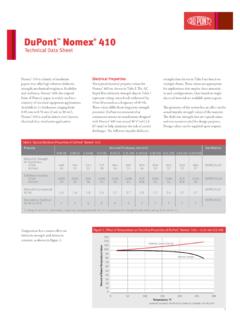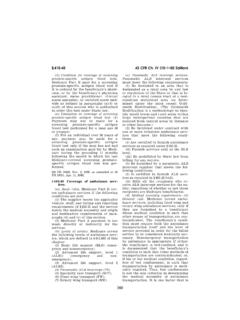Transcription of Health Planning Chapter 410-2-3 STATE HEALTH PLANNING …
1 HEALTH PLANNING Chapter 410-2-3 . STATE HEALTH PLANNING AND development agency . alabama STATE HEALTH PLAN. 2014-2017. ADMINISTRATIVE CODE. Chapter 410-2-3 . SPECIALTY SERVICES. TABLE OF CONTENTS. Introduction Neonatal Services Cardiac Services Oncology-Radiation Therapy Services End Stage Renal Disease Services Magnetic Resonance Imaging Extracorporeal Lithotresis New Technology Transplantation Services In Home Hospice Services Air Ambulance Introduction. This Chapter of the alabama STATE HEALTH Plan reviews the status of certain specialty HEALTH care services and the need for additional services to address the problems cited in the Priorities section of the Plan. Specialty Services are separately identified for ease of reference and to highlight their importance in the overall PLANNING and regulatory responsibilities.
2 The HEALTH care system in alabama should not be burdened by an unnecessary duplication of expensive services. Author: Statewide HEALTH Coordinating Council (SHCC). Statutory Authority: Code of Ala. 1975, 22-21-260(4). History: Effective May 18, 1993. Amended: Filed June 19, 1996;. effective July 25, 1996. Repealed and New Rule: Filed October 18, 2004; effective November 22, 2004. Amended (SHP Year Only): Filed December 2 2014; effective January 6, 2015. Neonatal Services. (1) Discussion (a) A leading indicator of the HEALTH status of a STATE 's citizens is the infant mortality rate. alabama has one Supp. 3/31/15 2-3-1. Chapter 410-2-3 HEALTH PLANNING of the highest rates in the country.
3 In order to have an impact on infant mortality, the STATE must make neonatal care accessible and enhance that care which is available. (b) Maternal and Neonatal service providers are designated as Basic (Level I), Specialty (Level II), or Subspecialty (Level III), depending on their capabilities and expertise. 1. A regionally coordinated system focusing on levels of hospital-based perinatal care has been shown to be effective and to result in improved outcomes for women and their newborns. According to the American College of Obstetricians and Gynecologists and the American Academy of Pediatrics, guidelines for Perinatal Care, Fifth Edition, prenatal care can be delivered more effectively and efficiently by defining the capabilities and expertise of providers and ensuring that pregnant women receive risk-appropriate care.
4 Basic (Level I) care should have the following capabilities and provider types: (i) Capabilities - Risk-oriented prenatal care record, physical examination and interpretation of findings, routine laboratory assessment, assessment of gestational age and normal progress of pregnancy, ongoing risk identification, mechanisms for consultation and referral, psychosocial support, childbirth education and care coordination (including referral for ancillary services, such as transportation, food, and housing assistance). (ii) Provider Types - Obstetricians, family physicians, certified nurse-midwives, and other advanced-practice nurses with experience, training, and demonstrated competence.
5 (iii) Responsibilities - Surveillance and care of all patients admitted to the obstetric service, with an established triage system for identifying high-risk patients who should be transferred to a facility that provides specialty or subspecialty care; proper detection and initial care of unanticipated maternal-fetal problems that occur during labor and delivery;. capability to perform cesarean delivery within 30 minutes of the decision to do so; availability of appropriate anesthesia, radiology, ultrasound, laboratory and blood bank services on a 24-hour basis; care of postpartum conditions; resuscitation and stabilization of all neonates born in the hospital; evaluation and continuing care of healthy neonates in a nursery or with their mothers until discharge; adequate nursery facilities and support for stabilization of small or ill neonates before transfer to a specialty or subspecialty facility; consultation and transfer arrangements; parent-sibling-neonate visitation; and data collection and retrieval.
6 Supp. 3/31/15 2-3-2. HEALTH PLANNING Chapter 410-2-3 . 2. Specialty (Level II) providers should have: (i) Capabilities - Basic care capabilities plus fetal diagnostic testing (eg, biophysical tests, amniotic fluid analysis, basic ultrasonography, and expertise in management of medical and obstetric complications. (ii) Provider Types - Obstetricians. (iii) Responsibilities - Provision of some enhanced services as well as basic care services as described in 1(iii);. care of appropriate high-risk women and fetuses, both admitted and transferred from other facilities; stabilization of severely ill newborns before transfer; treatment of moderately ill larger preterm and term newborns; and data collection and retrieval.)
7 3. Subspecialty (Level III) providers should have: (i) Capabilities - Basic and specialty care plus advanced fetal diagnoses (eg, targeted ultrasonography, fetal echo-cardiology); advanced therapy (eg, intrauterine fetal transfusion and treatment of cardiac arrhythmias); medical, surgical, neonatal, and genetic consultation; and management of severe maternal complications. (ii) Provider Types - Maternal-fetal medicine specialists and reproductive geneticists with experience, training and demonstrated competence. (iii) Responsibilities - Provision of comprehensive perinatal care services for both admitted and transferred women and neonates of all risk categories, including basic and specialty care services as described previously; evaluation of new technologies and therapies; and data collection and retrieval.
8 Neonatal services must continue to receive regional PLANNING . 4. Regional Subspecialty Perinatal HEALTH Care Center - Not all subspecialty perinatal HEALTH care hospitals must act as regional centers; however, regional organization of perinatal HEALTH care services requires that there be coordination in the development of specialized series, professional continuing education to maintain competency and the collection of data on long-term outcomes to evaluate both the effectiveness of delivery of perinatal HEALTH care services and the safety and efficacy of new therapies and technologies. 5. Specific responsibilities include: provision of comprehensive perinatal HEALTH care services at and above those of subspecialty care facilities; responsibility for regional Supp.
9 3/31/15 2-3-3. Chapter 410-2-3 HEALTH PLANNING perinatal HEALTH care service organization and coordination including: maternal and neonatal transport, outreach support and regional educational programs, research support and initial evaluation of new technologies and therapies, and analysis and evaluation of regional data, including those on perinatal complications and outcomes. (2) PLANNING Policies (a) In order to ensure that appropriate prenatal and neonatal services are available in alabama : 1. Each of the five (5) designated regional perinatal centers will have a high-risk nursery. 2. The STATE Perinatal Advisory Committee will continue to advise the STATE HEALTH Officer in the PLANNING , organization, and evaluation of the Perinatal Program, which will address the coordination of services to improve preconceptional, interconceptional and prenatal HEALTH for women at high risk for poor outcomes of pregnancy 3.
10 The alabama Perinatal Program will facilitate STATE , regional and local/community collaboration, interest and action regarding HEALTH care needs and services to reduce maternal, and childhood morbidity and mortality. 4. The alabama Perinatal Program will assess the quality and effectiveness of the HEALTH care systems for women and infants through the collection, analysis and reporting of data. 5. The STATE should strengthen the alabama Perinatal Program to implement programs that address recommendations issued by the STATE Perinatal Advisory Council (SPAC) in 2002: (i) Public Awareness Campaigns (ii) Smoking Cessation Interventions (iii) Statewide Fetal Infant Mortality Review Teams (iv) Evidence-Based Medicine/Best Practices (v) Regionalization of Perinatal Care (vi) Care Coordination Services (vii) Transportation for Women and Infants Supp.








